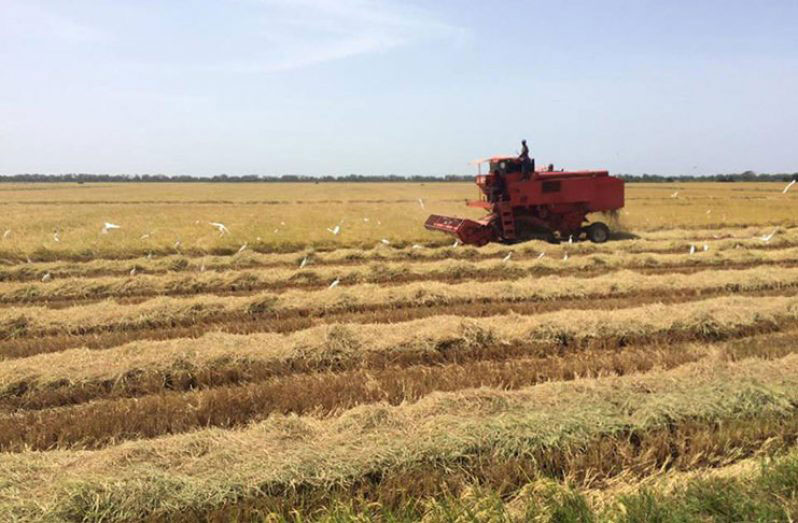BETWEEN January and March 2022, Guyana’s thriving rice industry raked in approximately US$37,022,500, an equivalent of more than GY$7.7 billion in export earnings, according to figures provided by the Ministry of Agriculture on Friday.
It was explained that these earnings derived from the exportation of approximately 49,304 tonnes of rice and rice products during the first quarter of 2022. Importantly, export revenues from rice are expected to grow even more, since many farmers across the country are still harvesting paddy from the year’s first rice crop, which commenced with countrywide sowing in November 2021.
At that time, the Guyana Rice Development Board (GRDB) had projected a bumber harvest, with most of the rice-producing regions being on target with their sowing. As a matter of fact, national sowing projections for the current crop were pegged at an overall target of 227,240 acres.
Last year, even with massive floods, the rice industry was still able to remain afloat, earning export revenues totalling GY$42.2 billion, an equivalent of US$201 million, resulting from the exportation of approximately 434,535 tonnes of rice, paddy and its by-products.
In 2021, the industry also benefited from increased markets, as the People’s Progressive Party/Civic (PPP/C) government successfully securing the British Virgin Islands (BVI), and the European nations of Estonia and Slovenia as lucrative buyers of Guyana’s top-notch rice produce.
The country was also able to solidify a standard rice supply agreement with sister country, Barbados, to ensure that the island-nation has a steady supply of the staple.
Agriculture Minister Zulfikar Mustapha had previously said that ongoing developments in the rice industry signal an even wider space for industry growth in 2022.
“We now have close to about 42 countries where we are exporting rice and we are looking to improve on that,” Minister Mustapha had previously told the government’s Department of Public Information.
Although the May 2021 floods devastated thousands of households and destroyed hundreds of hectares of farmlands, government’s $7.8 billion flood- relief programme was enough to enable the majority of affected rice farmers to return to their fields and resume production.
In January of this year, as part of the government’s landmark $552.9 billion budget, additional recovery mechanisms and measures were included, and these are expected to serve as a springboard for further advancement of Guyana’s rice industry.
As a matter of fact, for 2022 alone, the rice industry is projected to cop earnings in the vicinity of US$288.6 million, an equivalent of more than GY$60.3 billion.

“We see rice maintaining its importance and increasing its contribution in our economy, going forward,” Senior Minister in the Office of the President with responsibility for Finance, Dr Ashni Singh, said during his presentation of Budget 2022 to the National Assembly on January 26, 2022.
Aside from the industry’s recovery, which has already taken effect, a priority for the government, according Dr Singh, is to expand the cultivation of paddy and significantly boost production, especially as it relates to more value-added varieties and products. Already, plans are afoot to expand production by at least 8,000 hectares to 193,000 hectares by 2026.
“Focus in 2022 will see improved drainage and irrigation to mitigate losses, and expanded research on new high-yielding varieties and seed production.
In that regard, soil-testing facilities were made available to farmers through the construction of a soil laboratory at the Burma Rice Research Station,” Dr. Singh related.
As it is, a value-added laboratory for rice and rice products was completed in 2021.
Further, this year, the Guyana Rice Development Board (GRDB) will expend over $300 million in plant-breeding, agronomy, plant pathology, entomology and valued-added products as part of its research and development thrust.
Also, an additional $20 million is slated to be spent for the procurement of a seed dryer for Black Bush Polder, Region Six (East Berbice-Corentyne), one of the largest rice-producing communities of the country, and one of the many that were devastated by the aforementioned floods. This equipment is expected to benefit in excess of 600 rice farmers in the area.
Added to that, a mini-testing mill (polisher) will be acquired to analyse the quality of cargo rice and paddy.
In anticipation of expanded production and increased exports, six drying floors were constructed in Regions Two, Three, Five and Six in 2021. This year, two additional drying floors will be established in Regions Three and Four.
Continued investments in the overall agriculture industry is part of a wider effort by the Dr Irfaan Ali-led government to lower the food-importation bill of the Caribbean Community (CARICOM), by supplying the 15 member states with critical food commodities including rice, which remains a staple of the region’s diet.




.png)









